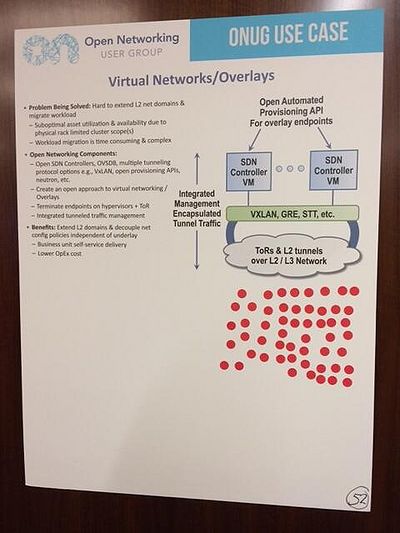Open Networking User Group
Last week JPMorgan Chase hosted the Open Networking User Group (ONUG) at its world headquarters in New York City. The two-day event included an academy and a closed-door session (no vendors) where users discussed and voted on the networking use cases that they wanted vendors to deliver. Attendance and engagement at the event was a great proof point that the networking industry is ready for a renaissance of new solutions that promise to deliver innovation, agility and new cost structures. This should be tempered with the reminder that change in the networking industry typically takes many years and there is a healthy skepticism amongst users about the reality of the maturity and full cost of the solutions that are currently available. As stated in the ONUG press release, the majority of users are looking to begin pilot engagements within the next year. The voice of this user community provides a much-needed counterbalance to hype from the vendor community.
See Wikibon’s coverage of SDN and Software-led Infrastructure
The Networking Opportunity
Networking is a diverse and complex part of the IT world. ONUG looks to review “open networking” which is a combination of a few of the broad disruptive forces that are impacting the space. First, there is Software Defined Networking (SDN) which can include OpenFlow, Network Virtualization and Overlays and/or NFV (see Sorting out SDN, NFV, Network Virtualization and the New Networking). In the past, the software layer of networking was tightly coupled with the hardware, now there is a move to separate the two and there is potential for the creation of a networking software ecosystem. In addition to SDN, open networking includes a new class of hardware, which can be hybrid switches (including a mix of merchant and custom silicon), white box switching (such as OCP), and also automation (DevOps/NetOps). Most of the industry focus is on the software (SDN/Network Virtualization), with an effort to improve the management of low level networking so that IT can deploy, scale and monitor deployments much easier than today. The Top 3 use cases from ONUG are all on the software side:
- Integrated Layer 4-7 Network Services
- Virtual Network Overlays
- Branch Software-Defined Wide Area Networks (SD-WANs)
Hardware and Cisco
The top attended session of the first day was on white box switching (presented by Cumulus Network’s JR Rivers – see our interview with him from VMworld). A top consideration for moving to white box solutions is to keep up with the rapid development cycles of hardware, similar to x86. Additionally, a Linux OS (such as what Cumulus offers) would allow for management and control of the environment that fits into existing paradigm of Linux administrators. While there is a drastic cost savings on hardware and much potential to significantly improve operations, users were much more wary of the new hardware options. Cisco is expected to make a big announcement this week about Application Centric Infrastructure (see my interview with Soni Jiandani of Insieme from VMworld) and there are discussions that Cisco’s offering will be a hybrid (merchant and custom silicon). Cisco’s increased presence in SDN and merchant silicon will help to validate the markets that startups and other competitors have been pushing for the last few years. According to a financial analyst at ONUG, Cisco is being squeezed by SDN players at the top of the market and cloud solutions at the bottom, and price/port is the big concern. Cisco makes high margins, especially for optics and cabling (which are often overlooked but are a significant piece of overall networking costs – here’s a good 40GbE cabling FAQ from Arista); if software and hardware decisions can be separated, Cisco’s dominance would be under serious attack. In a multi-billion dollar market, SDN is only expected to be in the $100Ms by 2015 and much of that will be in L4-L7 (the top use case voted by attendees).
Action Item: The SDN market does not yet have any clear leaders, but definitions and use cases are emerging. The networking community is a cautious group, so the enthusiasm and participation across many industries is a clear indicator of a concerted effort to solve real pain points, not just hype around software-defined something. Practitioners are urged to start with a pilot to test various solutions and engage with peers (including groups such as ONUG). Open Networking should not be evaluated solely from the networking group, rather it should be part of broader discussions such as Open Stack and the pervasive use of virtualization(SDDC).



